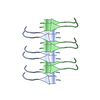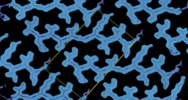[English] 日本語
 Yorodumi
Yorodumi- EMDB-8765: MicroED structure of the segment, DLIIKGISVHI, from the RRM2 of T... -
+ Open data
Open data
- Basic information
Basic information
| Entry | Database: EMDB / ID: EMD-8765 | |||||||||
|---|---|---|---|---|---|---|---|---|---|---|
| Title | MicroED structure of the segment, DLIIKGISVHI, from the RRM2 of TDP-43, residues 247-257 | |||||||||
 Map data Map data | Peptide DLIIKGISVHI from the RRM2 of TDP-43, residues 247-257 | |||||||||
 Sample Sample |
| |||||||||
 Keywords Keywords | Amyloid / steric zipper / PROTEIN FIBRIL | |||||||||
| Function / homology |  Function and homology information Function and homology informationnuclear inner membrane organization / interchromatin granule / perichromatin fibrils / 3'-UTR-mediated mRNA destabilization / 3'-UTR-mediated mRNA stabilization / intracellular membraneless organelle / negative regulation of protein phosphorylation / host-mediated suppression of viral transcription / pre-mRNA intronic binding / RNA splicing ...nuclear inner membrane organization / interchromatin granule / perichromatin fibrils / 3'-UTR-mediated mRNA destabilization / 3'-UTR-mediated mRNA stabilization / intracellular membraneless organelle / negative regulation of protein phosphorylation / host-mediated suppression of viral transcription / pre-mRNA intronic binding / RNA splicing / response to endoplasmic reticulum stress / mRNA 3'-UTR binding / molecular condensate scaffold activity / positive regulation of insulin secretion / regulation of circadian rhythm / regulation of protein stability / positive regulation of protein import into nucleus / mRNA processing / cytoplasmic stress granule / rhythmic process / regulation of gene expression / double-stranded DNA binding / regulation of apoptotic process / amyloid fibril formation / regulation of cell cycle / nuclear speck / RNA polymerase II cis-regulatory region sequence-specific DNA binding / negative regulation of gene expression / lipid binding / chromatin / mitochondrion / DNA binding / RNA binding / nucleoplasm / identical protein binding / nucleus Similarity search - Function | |||||||||
| Biological species |  Homo sapiens (human) Homo sapiens (human) | |||||||||
| Method | electron crystallography / cryo EM | |||||||||
 Authors Authors | Guenther EL / Sawaya MR | |||||||||
| Funding support |  United States, 1 items United States, 1 items
| |||||||||
 Citation Citation |  Journal: Nat Struct Mol Biol / Year: 2018 Journal: Nat Struct Mol Biol / Year: 2018Title: Atomic-level evidence for packing and positional amyloid polymorphism by segment from TDP-43 RRM2. Authors: Elizabeth L Guenther / Peng Ge / Hamilton Trinh / Michael R Sawaya / Duilio Cascio / David R Boyer / Tamir Gonen / Z Hong Zhou / David S Eisenberg /  Abstract: Proteins in the fibrous amyloid state are a major hallmark of neurodegenerative disease. Understanding the multiple conformations, or polymorphs, of amyloid proteins at the molecular level is a ...Proteins in the fibrous amyloid state are a major hallmark of neurodegenerative disease. Understanding the multiple conformations, or polymorphs, of amyloid proteins at the molecular level is a challenge of amyloid research. Here, we detail the wide range of polymorphs formed by a segment of human TAR DNA-binding protein 43 (TDP-43) as a model for the polymorphic capabilities of pathological amyloid aggregation. Using X-ray diffraction, microelectron diffraction (MicroED) and single-particle cryo-EM, we show that the DLIIKGISVHI segment from the second RNA-recognition motif (RRM2) forms an array of amyloid polymorphs. These associations include seven distinct interfaces displaying five different symmetry classes of steric zippers. Additionally, we find that this segment can adopt three different backbone conformations that contribute to its polymorphic capabilities. The polymorphic nature of this segment illustrates at the molecular level how amyloid proteins can form diverse fibril structures. | |||||||||
| History |
|
- Structure visualization
Structure visualization
| Movie |
 Movie viewer Movie viewer |
|---|---|
| Structure viewer | EM map:  SurfView SurfView Molmil Molmil Jmol/JSmol Jmol/JSmol |
| Supplemental images |
- Downloads & links
Downloads & links
-EMDB archive
| Map data |  emd_8765.map.gz emd_8765.map.gz | 413.6 KB |  EMDB map data format EMDB map data format | |
|---|---|---|---|---|
| Header (meta data) |  emd-8765-v30.xml emd-8765-v30.xml emd-8765.xml emd-8765.xml | 10.2 KB 10.2 KB | Display Display |  EMDB header EMDB header |
| Images |  emd_8765.png emd_8765.png | 347.3 KB | ||
| Filedesc metadata |  emd-8765.cif.gz emd-8765.cif.gz | 4.5 KB | ||
| Filedesc structureFactors |  emd_8765_sf.cif.gz emd_8765_sf.cif.gz | 32.5 KB | ||
| Archive directory |  http://ftp.pdbj.org/pub/emdb/structures/EMD-8765 http://ftp.pdbj.org/pub/emdb/structures/EMD-8765 ftp://ftp.pdbj.org/pub/emdb/structures/EMD-8765 ftp://ftp.pdbj.org/pub/emdb/structures/EMD-8765 | HTTPS FTP |
-Validation report
| Summary document |  emd_8765_validation.pdf.gz emd_8765_validation.pdf.gz | 456 KB | Display |  EMDB validaton report EMDB validaton report |
|---|---|---|---|---|
| Full document |  emd_8765_full_validation.pdf.gz emd_8765_full_validation.pdf.gz | 455.6 KB | Display | |
| Data in XML |  emd_8765_validation.xml.gz emd_8765_validation.xml.gz | 4.2 KB | Display | |
| Data in CIF |  emd_8765_validation.cif.gz emd_8765_validation.cif.gz | 4.7 KB | Display | |
| Arichive directory |  https://ftp.pdbj.org/pub/emdb/validation_reports/EMD-8765 https://ftp.pdbj.org/pub/emdb/validation_reports/EMD-8765 ftp://ftp.pdbj.org/pub/emdb/validation_reports/EMD-8765 ftp://ftp.pdbj.org/pub/emdb/validation_reports/EMD-8765 | HTTPS FTP |
-Related structure data
| Related structure data |  5w52MC  8781C  5w50C  5w7vC M: atomic model generated by this map C: citing same article ( |
|---|---|
| Similar structure data | Similarity search - Function & homology  F&H Search F&H Search |
- Links
Links
| EMDB pages |  EMDB (EBI/PDBe) / EMDB (EBI/PDBe) /  EMDataResource EMDataResource |
|---|---|
| Related items in Molecule of the Month |
- Map
Map
| File |  Download / File: emd_8765.map.gz / Format: CCP4 / Size: 1.6 MB / Type: IMAGE STORED AS FLOATING POINT NUMBER (4 BYTES) Download / File: emd_8765.map.gz / Format: CCP4 / Size: 1.6 MB / Type: IMAGE STORED AS FLOATING POINT NUMBER (4 BYTES) | ||||||||||||||||||||||||||||||||||||||||||||||||||||||||||||||||||||
|---|---|---|---|---|---|---|---|---|---|---|---|---|---|---|---|---|---|---|---|---|---|---|---|---|---|---|---|---|---|---|---|---|---|---|---|---|---|---|---|---|---|---|---|---|---|---|---|---|---|---|---|---|---|---|---|---|---|---|---|---|---|---|---|---|---|---|---|---|---|
| Annotation | Peptide DLIIKGISVHI from the RRM2 of TDP-43, residues 247-257 | ||||||||||||||||||||||||||||||||||||||||||||||||||||||||||||||||||||
| Projections & slices | Image control
Images are generated by Spider. generated in cubic-lattice coordinate | ||||||||||||||||||||||||||||||||||||||||||||||||||||||||||||||||||||
| Voxel size | X: 0.443 Å / Y: 0.338 Å / Z: 0.417 Å | ||||||||||||||||||||||||||||||||||||||||||||||||||||||||||||||||||||
| Density |
| ||||||||||||||||||||||||||||||||||||||||||||||||||||||||||||||||||||
| Symmetry | Space group: 1 | ||||||||||||||||||||||||||||||||||||||||||||||||||||||||||||||||||||
| Details | EMDB XML:
CCP4 map header:
| ||||||||||||||||||||||||||||||||||||||||||||||||||||||||||||||||||||
-Supplemental data
- Sample components
Sample components
-Entire : DLIIKGISVHI fibril
| Entire | Name: DLIIKGISVHI fibril |
|---|---|
| Components |
|
-Supramolecule #1: DLIIKGISVHI fibril
| Supramolecule | Name: DLIIKGISVHI fibril / type: complex / ID: 1 / Parent: 0 / Macromolecule list: all / Details: This peptide was synthesized and crystallized. |
|---|---|
| Source (natural) | Organism:  Homo sapiens (human) Homo sapiens (human) |
| Molecular weight | Theoretical: 5.03 kDa/nm |
-Macromolecule #1: TAR DNA-binding protein 43
| Macromolecule | Name: TAR DNA-binding protein 43 / type: protein_or_peptide / ID: 1 / Number of copies: 1 / Enantiomer: LEVO |
|---|---|
| Source (natural) | Organism:  Homo sapiens (human) Homo sapiens (human) |
| Molecular weight | Theoretical: 1.209479 KDa |
| Sequence | String: DLIIKGISVH I UniProtKB: TAR DNA-binding protein 43 |
-Experimental details
-Structure determination
| Method | cryo EM |
|---|---|
 Processing Processing | electron crystallography |
| Aggregation state | 3D array |
- Sample preparation
Sample preparation
| Buffer | pH: 8.5 |
|---|---|
| Vitrification | Cryogen name: ETHANE |
- Electron microscopy
Electron microscopy
| Microscope | FEI TECNAI 20 |
|---|---|
| Image recording | Film or detector model: TVIPS TEMCAM-F416 (4k x 4k) / Average electron dose: 3.4 e/Å2 |
| Electron beam | Acceleration voltage: 200 kV / Electron source:  FIELD EMISSION GUN FIELD EMISSION GUN |
| Electron optics | Illumination mode: FLOOD BEAM / Imaging mode: DIFFRACTION / Camera length: 1840 mm |
- Image processing
Image processing
| Final reconstruction | Resolution method: DIFFRACTION PATTERN/LAYERLINES |
|---|---|
| Molecular replacement | Software - Name: Phaser |
| Merging software list | Software - Name: XSCALE |
| Crystallography statistics | Number intensities measured: 9353 / Number structure factors: 1037 / Fourier space coverage: 73.4 / R sym: 20.3 / R merge: 20.3 / Overall phase error: 0.001 / Overall phase residual: 0.001 / Phase error rejection criteria: 1 / High resolution: 1.4 Å / Shell - Shell ID: 1 / Shell - High resolution: 1.4 Å / Shell - Low resolution: 1.48 Å / Shell - Number structure factors: 139 / Shell - Phase residual: 0.001 / Shell - Fourier space coverage: 62.1 / Shell - Multiplicity: 6.71 |
 Movie
Movie Controller
Controller




 Y (Sec.)
Y (Sec.) X (Row.)
X (Row.) Z (Col.)
Z (Col.)





















